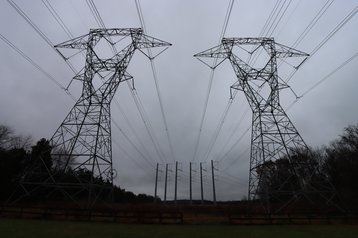PJM Interconnection expects energy demand in its transmission zones to jump almost 40 percent over the next 15 years, driven largely by data center growth.
PJM is a regional transmission organization (RTO) coordinating wholesale electricity across 13 states and the District of Columbia – including major data center hotspots such as Virginia and Ohio.
The organization this week published its 2024 PJM Load Forecast Report, outlining forecasted energy demand across its transmission region.
Total annual energy use throughout the PJM footprint is expected to increase nearly 40 percent by 2039, from 800,000 gigawatt-hours (GWh) to about 1.1 million GWh.
“Rising energy demand in the region PJM serves is increasingly driven by the development of data centers throughout the PJM footprint, combined with the accelerating electrification of transportation and industry,” PJM said.
PJM predicts 2024 summer demand will reach 151,254MW, with summer peak load increasing to 178,895MW in 2034 and 193,123MW in 2039, an increase of nearly 42,000MW. Winter peak loads are forecast to reach 134,663 MW for the 2023–2024 winter, rising to 164,824MW in 2034 and 178,241MW in 2039, an increase of more than 43,000MW.
Both summer and winter peaks are well above the 2023 forecast report. Last year, summer peaks were forecasted to reach 167,567MW by 2038; a 15-year increase of just 18,507MW. Winter peaks for the same period were expected to reach 150,555MW in 2037/38, a 15-year increase of 19,744MW.
In Virginia, demand on Dominion’s portion of the grid is expected to jump from around 22,000MW today to around 42,000MW by 2039.
Large loads that may come into the grid in the future include a number of new data center developments and the upcoming Intel chip plant outside of Columbus, Ohio; the gigawatt-scale Quantum Loophole Frederick campus in Maryland, ongoing data center growth in Virginia, and data center growth in New Jersey.
In the release announcing the report, PJM noted that increased electricity demand, combined with accelerated generator retirements and the slow pace of replacement generation, will “challenge reliability in the PJM footprint by 2030 if not addressed.”
At the end of 2023, PJM said around 40,000MW of projects that had completed the PJM study process had yet to move through construction, due to issues including siting, supply chain, and/or financing.
An announcement from late last year said PJM is expected to clear 300 new generation projects for interconnection in 2024, totaling 26,000MW. PJM also identified another 46,000MW of nameplate generation capacity in projects that should clear PJM’s study process and be ready for construction by mid-2025, for a total of 72,000MW of mostly renewable and battery projects.
“Interconnection process reform is delivering on the commitment made by PJM and its stakeholders to speed the study process for the thousands of new generation projects to connect with the PJM grid,” said Ken Seiler, SVP of planning. “While siting and supply chain issues continue to slow the development of new generation resources, there will be a growing number of projects approved for interconnection in the near term.”
This week, PJM announced it had asked Talen Energy to continue to operate two oil-fired generating units in Maryland until transmission upgrades are in service in 2028 in order to “mitigate reliability impacts” their retirement would cause to the grid.
October 2023 saw Talen announce plans to retire the two Wagner facilities, consisting of three oil-fired units and a natural gas combustion turbine unit totaling 844MW, in 2025 citing environmental permitting and economic reasons.
“After conducting its standard generator deactivation studies, PJM’s Jan. 4 response (PDF) informed Talen that the deactivation of units 3 and 4 would adversely affect the reliability of the system absent transmission upgrades,” PJM said this week. “Therefore, PJM requested that Talen continue to operate Wagner units 3 and 4 under a Reliability Must Run (RMR) arrangement until the planned upgrades are completed.”
In California, Silicon Valley Power recently said it predicts data center load in its area of responsibility to double by 2035, requiring geothermal power and battery systems in order to keep up with demand.







